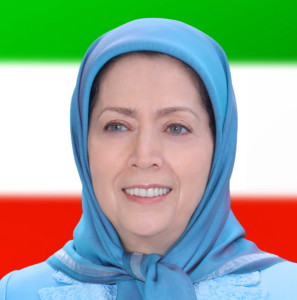The Regime’s Overthrow Is Certain, Iran Will Be Free
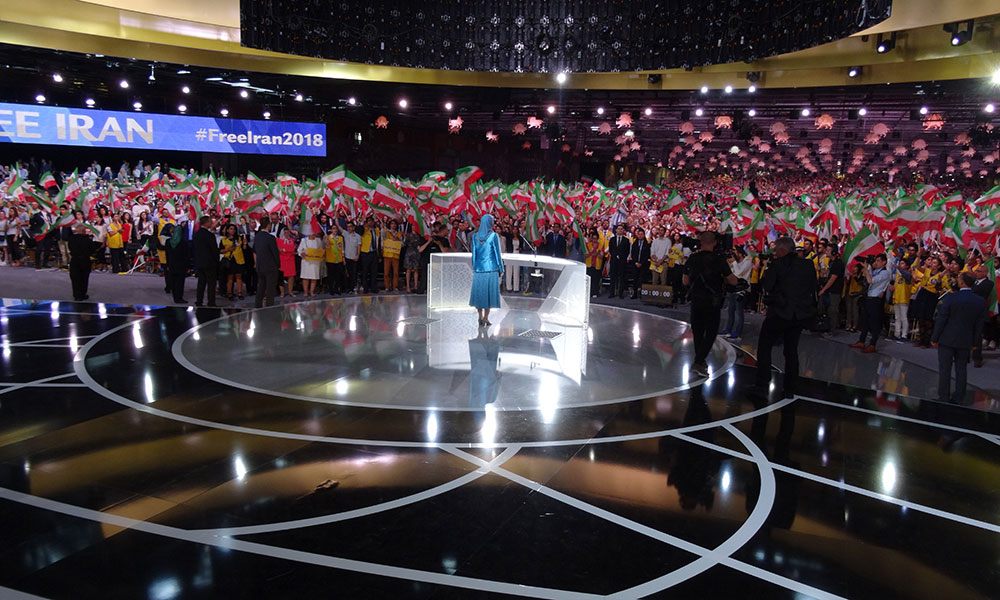
Speech by Maryam Rajavi At the Resistance’s Grand Gathering- Paris, June 30, 2018
On Saturday, June 30, 2018, the Iranian Resistance’s grand gathering was held in Paris, France. Delegations from various countries including prominent politicians, members of parliaments, mayors, elected representatives, and international experts on Iran attended the huge event. The speakers declared their support for the Iranian people’s uprising and the democratic alternative, the National Council of Resistance of Iran. They called on the international community to adopt a firm policy toward the mullahs’ religious fascist tyranny and to stand by the arisen people of Iran. Below is the full text of Maryam Rajavi’s keynote address.
My fellow compatriots,
Dear friends,
Elected representatives, honorable dignitaries from across the world,
Greetings to all of you and to my dear compatriots in Iran and all over the world. The first thing that must be said today is that the flames of the auspicious and liberating uprising are again rising in Tehran and across Iran: Once again in Mashhad and Shiraz, Bandar Abbas and Qeshm, Karaj and Kermanshah, Shahriar, Islamshahr, Kashan, Arak, Isfahan, Ram Hormuz, and many other towns and cities.
Indeed, the flames of the protests cannot be extinguished and they will continue to soar without respite, indicating a constantly expanding and deepening uprising.
The thunderous voices of rebellious youths in various cities represent the beating heart of a nation immersed in the euphoria of a free Iran.
Once again, I salute my fellow compatriots in Khorramshahr, who are thirsting for water and for freedom. You unequivocally told the mullahs that their prayers are not acceptable in the eyes of God.
I have come here on behalf of a Resistance movement which has offered its entire existence to secure victory for the Iran uprising, and for Iran’s freedom, pride, and magnificence.
I have come here to reiterate what you, arisen people of Iran seek: The time has come for the regime’s overthrow. Victory is certain and Iran will be free.
And we salute the People’s Mojahedin Organization of Iran (PMOI/MEK) members in Ashraf #3, the home of the passionate (in Albania). Congratulations for constructing it with your own hands.
And onwards with 1,000 Ashrafs (resistance units) in our occupied homeland.
The leverage for the overthrow
Since the January uprising, the tip of the volcano of change and the regime’s overthrow in Iran has emerged. The triumph of Iran’s democratic revolution, without the sheikh (mullahs) and the Shah, are now looming on the horizon. Through their uprisings and relying on resistance units, the Iranian people are employing the leverage they need to topple this regime.
How and where can we discover these realities?
First, owing to the presence of the Resistance movement, the charade billed as the existence of a “solution” within the religious fascism has become null and void.
The rebellious population and youth have rejected both factions of the regime. These are the same fearless youth who have chosen the path of fighting on, going on the maximum offensive, and waging resistance regardless of the cost.
The persistence of the uprising and the protest movement despite maximum suppression
The second sign that the era of the regime’s overthrow has arrived is that for the past six months the Iranian people have waged an uprising and a protest movement despite the imposition of maximum suppression, despite the so-called “suicides” of the detainees in the mullahs’ prisons and despite daily arrests and executions designed to intimidate the public.
The workers at Haft-Tapeh sugar cane factory resumed their uprising. Then, the workers at Ahvaz steel factory, and farmers in Isfahan rose up. Worshipers in Isfahan turned their backs on Khamenei’s Friday prayer leader and chanted: “My back to the enemy and facing the nation.”
Isfahan Province was still on edge when our Arab compatriots in Khuzestan, especially in Ahvaz, rose up. Then came Kurdistan as the lengthy strike in Baneh aroused everyone’s admiration. Then, on the roadmap to overthrow, a new role model emerged: Kazerun, the city of uprising, fire and blood, with audacious women, who alongside their brothers and rocks in hand, repelled the heavily-armed enemy forces, imitating the resistance we saw at Camp Ashraf.
At that moment, the uprising accelerated. The strike by toiling truck drivers and owners in 285 cities and in 31 provinces shook the regime to its foundation for 12 days.
Teachers, retirees, defrauded investors, and workers of hundreds of manufacturing units rose up day after day. And last week, the Tehran bazaar rose up and ignited an uprising in Tehran and other cities.
Iran revolted once again, with all its children, with all its nationalities and ethnicities.
Truly, where is the destination? The answer is: A free Iran, through the eradication of all the facets of dictatorship and plundering policies, and by bringing down Khamenei from power.
An explosive and irreversible situation
The third sign of the inevitable overthrow of the ruling religious fascism is that social tensions and economic crises, especially high prices, unemployment, poverty, and inequality have reached a critical mass. Everyone senses the explosive state of society. And the mullahs can offer neither a solution nor are willing or able to resolve the problems.
The velayat-e faqih (absolute clerical rule) lacks all legitimacy. Khamenei’s standing has plummeted dramatically. The regime has run out of cash. The Revolutionary Guards and the unpopular Bassij forces have been facing defections. The masquerade of “moderation” designed to preserve the regime has now been unmasked. And the regime in its entirety is drowning in the abyss of internal feuds and bickering.
And now, it is the regime’s own advocates who are confessing that there are two rival governments at the apex of the ruling establishment. One regime advocate openly said: “We are getting close to a watershed moment that will see the ouster of one of the two governments, and either the hidden government will take full control of administering the affairs, or it will be forced to relinquish portions of its authority.”
The collapse of the appeasement policy
The fourth sign of the phase of the regime’s overthrow is that internationally, the mullahs have lost the most important backer of the policy of appeasement, namely the United States. The international shield safeguarding the regime has fallen by the way side. The mullahs have practically lost their JCPOA. The avalanche of successive sanctions is hitting them hard, undercutting their ability to engage in warmongering and adventurism in the region. An arms and oil embargo, which was demanded by the Iranian Resistance since four decades ago, is now in the process of being somewhat implemented. And the era of labeling, bombing and suppressing the opposition at the behest of the regime and for the benefit of the regime has come to an end.
The blood of martyrs and suffering of those detained fuel the fire of the uprisings
The fifth and most important indication that the mullahs’ regime has entered the era of being overthrown is that the very development the mullahs have feared the most is now a reality: that is, the link and relationship between the fury of the deprived and oppressed on the one hand and the organized Resistance movement on the other. All regime leaders and junior and senior officials have repeatedly confessed to this fact. This is their way of admitting that the regime’s rule is nearing its end.
Indeed, the regime is on the brink of overthrow.
Prior to this, in 2013, following the massacre of 52 PMOI members at Camp Ashraf, when several residents were taken hostage, Massoud Rajavi announced the roadmap for creating 1,000 Ashrafs (resistance units) inside Iran so that the organization that leads the uprising could be linked to the arisen people of Iran. Accordingly, units and councils for the national resistance became the tip of the spear of the strategy for uprising and overthrow in Iran’s risen and revolting cities. This is how the blood of the martyrs and the suffering of those detained since June 20, 1981 until today, are fueling the uprisings. As Massoud Rajavi said, “If Iran stands, the world will stand with us and by our side.”
A euphoric generation thirsting for freedom has risen up. Those taking part in the uprising joined by resistance units have now charted a new territory. Rise up and walk along this path. Join hands with them and heed their call for a free Iran; declare your readiness.
You saw when the people of Varzaneh took over the city’s entry points. Kazerunis took over the streets, and truck drivers and owners took over the highways. And you saw how the young people in Tehran, in Lalehzar, Ferdowsi, Shoush, Mellat and Ekbatan exhibited enormous courage in confronting the ruthless security agents, building entrenchments in the streets.
This is the Iranian nation’s fight to capture the entire country and take back Iran from the occupiers, the mullahs.
The overthrow of this regime requires resistance units and a liberation army
These days, an industry of concocting phony alternatives has become prevalent in the political arena, of course copying and pasting aspects from others. And this in itself is another sign of the phase of the regime’s overthrow. But the crux of the matter is how they are going to actually bring down this regime in practice. This question is especially relevant as the blood of the martyrs has permanently and historically blocked the path to reform within the clerical regime and the return of the monarchy.
Now, if one can topple this regime without an organization and leadership, without overcoming thorny trials, and without paying the price and making sacrifices, we say: Please, go ahead, don’t delay.
If one can restore the people’s sovereignty without a history of fighting against two regimes, without drawing boundaries against dictatorship, subordination and dependency, without waging a nationwide resistance and offering a galaxy of martyrs, without challenging the principle of the velayat-e faqih and phony regime “moderates,” we say: Please, go ahead, don’t delay.
If one can topple the mullahs without challenging Khomeini over the unpatriotic Iran-Iraq war, forcing an end to the inferno of that war, and discrediting the regime’s slogan of “liberating Qods via Karbala”; without compelling Khomeini to accept the ceasefire by launching 100 military operations by the National Liberation Army of Iran, which captured the city of Mehran and marched to the gates of Kermanshah; and without exposing the regime’s nuclear weapons, missile, chemical and microbiological programs and facilities, yes, go ahead and don’t delay.
If one can leap frog a fifty-year history overnight and create real change in Iran while dreaming about foreign support, and without having to expose the regime’s human rights abuses and crimes in 64 UN resolutions, without the campaign for justice for the massacre of political prisoners in 1988, without campaigns by supporters of the resistance worldwide and insisting on the rights of the Iranian nation for four decades, without having a specific platform and programs of the NCRI and the Provisional Government for the transition of sovereignty to the Iranian people, and finally without a tested leader, who has guided this ferocious struggle for five decades, if all this could instead be done overnight, we say: go ahead, the ball is in your court.
But let me say this: Such a fantasy is only possible through an Iraq-like occupation, or in other words through a foreign intervention. The aftermath of this scenario is already known.
Over the past 40 years, all those aspiring opponents who were nonetheless unwilling to pay the price have had opportunities to test their luck. But the hard realities and real experiences have shown that this dark and evil regime will neither be reformed nor turn “green” or “velvet.”
The overthrow of this regime inevitably requires a willingness to pay the necessary price, it requires the practice of honesty and sacrifice, it requires an organization and a sturdy political alternative, and it requires the organization of resistance units and an army of liberation.
Nevertheless, as Massoud Rajavi said in the context of evaluating the January uprising: “We are not in competition with anyone seeking to assume power. On the other hand and most certainly, no one can compete with the PMOI when it comes to practicing honesty, sacrifice and paying the price.”
National Solidarity Front to overthrow the religious dictatorship
16 years ago, the Iranian Resistance adopted a plan called the National Solidarity Front for the Overthrow of the Ruling Religious Dictatorship and declared that it was prepared to cooperate will all forces who want a republic, who are committed to the complete rejection of the velayat-e faqih regime and who struggle for a democratic, independent Iran, based on separation of religion and state.
Over the past four decades, the NCRI, beyond typical political rhetoric, has paid a heavy price in blood and treasure for each and every one of its declarations, ratifications and commitments.
We call for the establishment of a society based on freedom, democracy, and equality, which has clear demarcation lines against despotism and dependence as well as gender, ethnic and class discrimination. We have defended and will continue to defend gender equality, the right to freely choose one’s attire, separation of religion and state, autonomy of nationalities, equal political and social rights for all citizens of Iran, abolition of the death penalty, freedom of expression, parties, the media, assembly, unions, associations, councils and syndicates.
The NCRI’s 12-point plan for the autonomy of the Iranian Kurdistan, adopted and announced 35 years ago, remains to be one of the most comprehensive examples globally for addressing the rights of nationalities. And, in the end, a free and non-nuclear Iran will promote peaceful coexistence with its neighbors, and would embrace regional and international cooperation.
This is the image of the democratic alternative, which rejects the mullahs’ rule or any form of dictatorship.
On this path, the first step is to transfer sovereignty to the people of Iran. By relying on the Iranian people and a popular social base, one can avert chaos and insecurity and safeguard the integrity of Iran and Iranians, rendering it a proud nation.
According to the NCRI’s program, following the regime’s overthrow, a provisional six-month government will be formed, whose primary task is to form a constituent assembly through free elections on the basis of popular, direct, equal and secret ballot. This constituent assembly must draft the constitution of the new republic within two years and put it to popular vote. It must also set up the principal institutions of the new republic based on the people’s vote.
The violated sovereignty of the Iranian people must be revived
We believe it is possible to eradicate high prices, poverty, unemployment, shanty towns, water shortages and environmental calamities. But, before anything else, the trampled political rights, specifically the right to sovereignty of the Iranian people, must be restored and revived. This is the aim of our Resistance and the raison d’etre for the NCRI.
But the Iranian regime has benefitted the most by denying the wherewithal of this Resistance and this alternative and by using western appeasers to suppress this movement.
Therefore, as far as Iran in concerned, without recognizing the Resistance and the right to resist, the damages that the policy of appeasement has so far inflicted on the Iranian people cannot be rectified.
As we have always stated, and I reiterate here, the task of overthrowing the regime, bringing about democratic change and establishing a free Iran rests on our own shoulders and those of the Iranian people. At the same time, we would welcome any retreat by the mullahs because one thousand chalices of poison would ultimately serve the interests of 1,000 Ashrafs (resistance units).
Today, the brave youth of Iran have completely dedicated themselves to the task of sustaining the uprising. I hail the courageous women of Iran, who are leading the way everywhere. I also hail the young people and members of resistance units, who even while in captivity insist on declaring their PMOI identity, which terrifies the regime.
In Lockstep with the uprising, every single second
Making sacrifices to advance the uprising
I call upon all of you to provide practical support to the uprisings. All Iranians, wherever they are, can help and advance the uprising. Also, you, the Iranian youth, who are present here, can do a lot. This is our collective commitment and our collective pledge to the Iranian nation to place everything at the service of the uprisings, giving it all we have and making sacrifices in all fronts in order to advance the uprising.
Literally, every single one of us will be with the uprising every moment and every second of every day.
I hail all the martyrs and defiant prisoners since June 20, 1981, until today. I hail those eternal flames of love, Sediqeh Mojaveri and Neda Hassani, on the 15th anniversary of their martyrdom. May their memories and names last forever!
I am well aware that your unsparing emotions are directed at the galaxy of martyrs of the Resistance and the Iranian people’s liberation army as well as those in the uprisings, the resistance units and the steadfast and persevering prisoners, especially those massacred in 1988 in the regime’s prisons 30 years ago.
From the depths of the dark night
A rose blossoms
Winter will no doubt pass, and
The harbinger of spring, thousands of roses in hand, will certainly follow
Hail to freedom
Hail to the people of Iran
Hail to all of you.
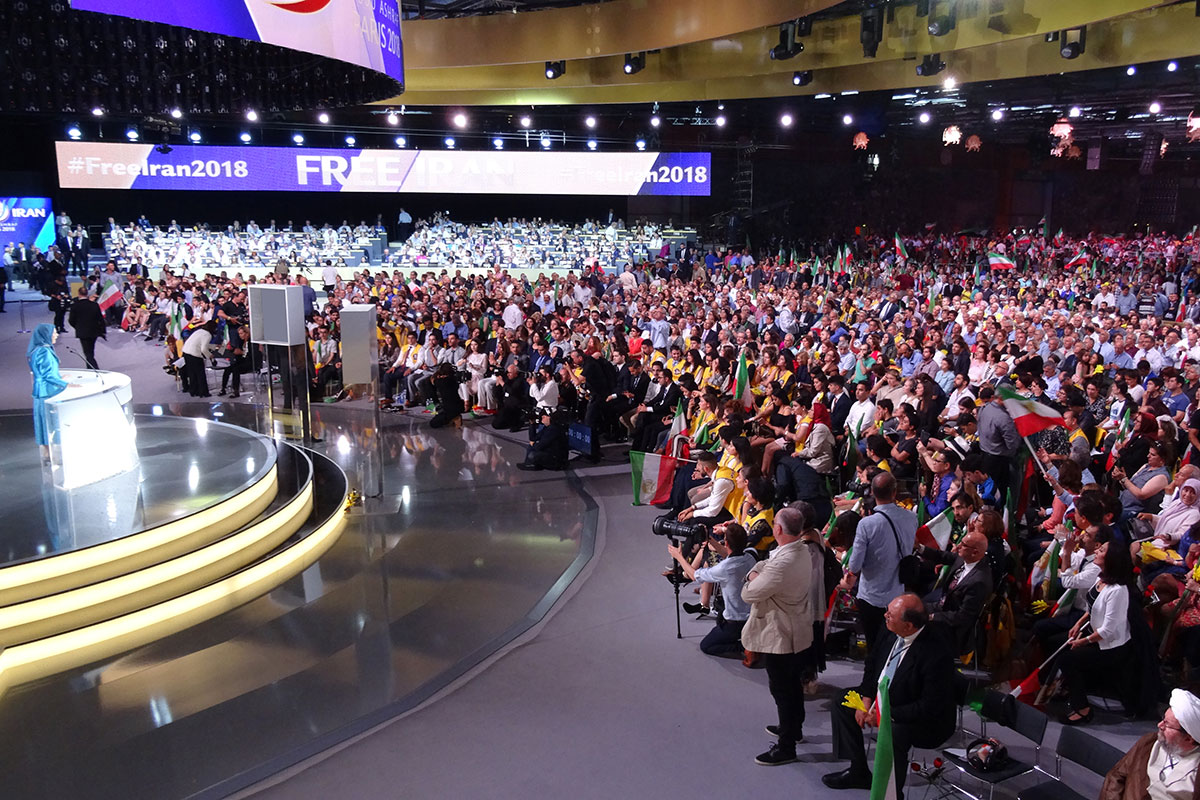
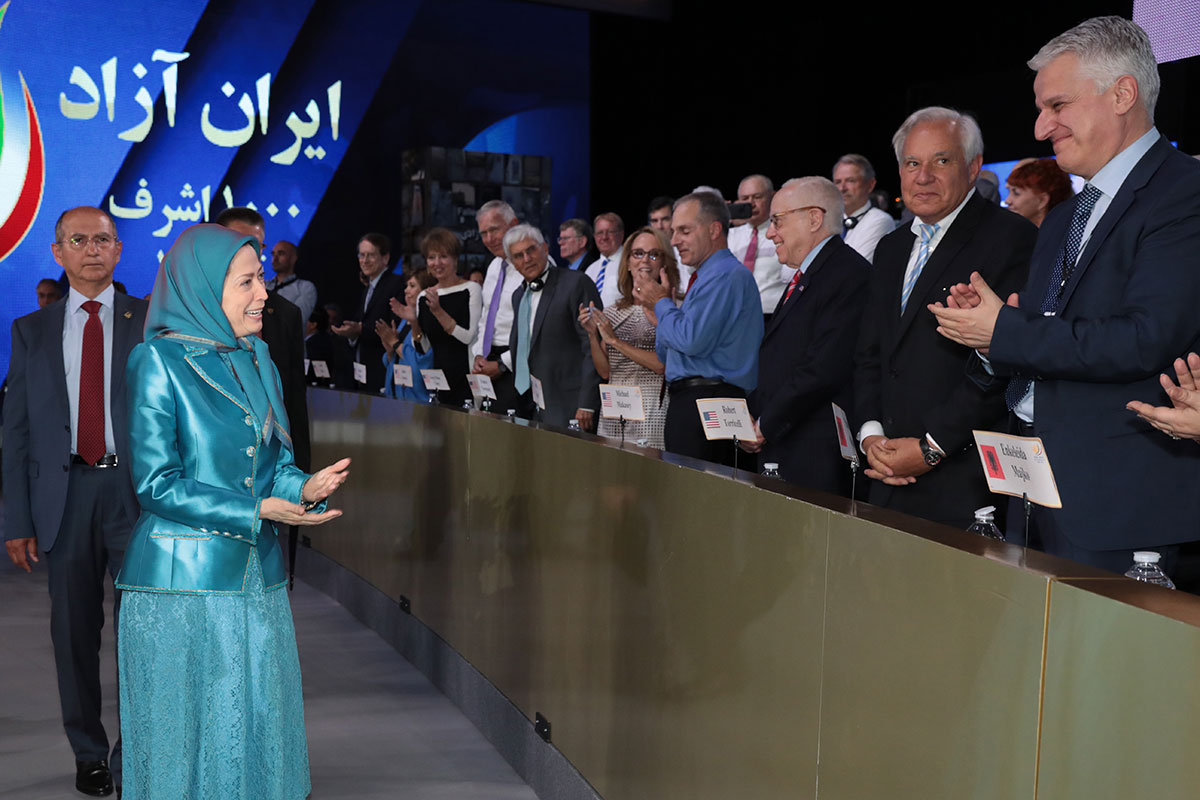
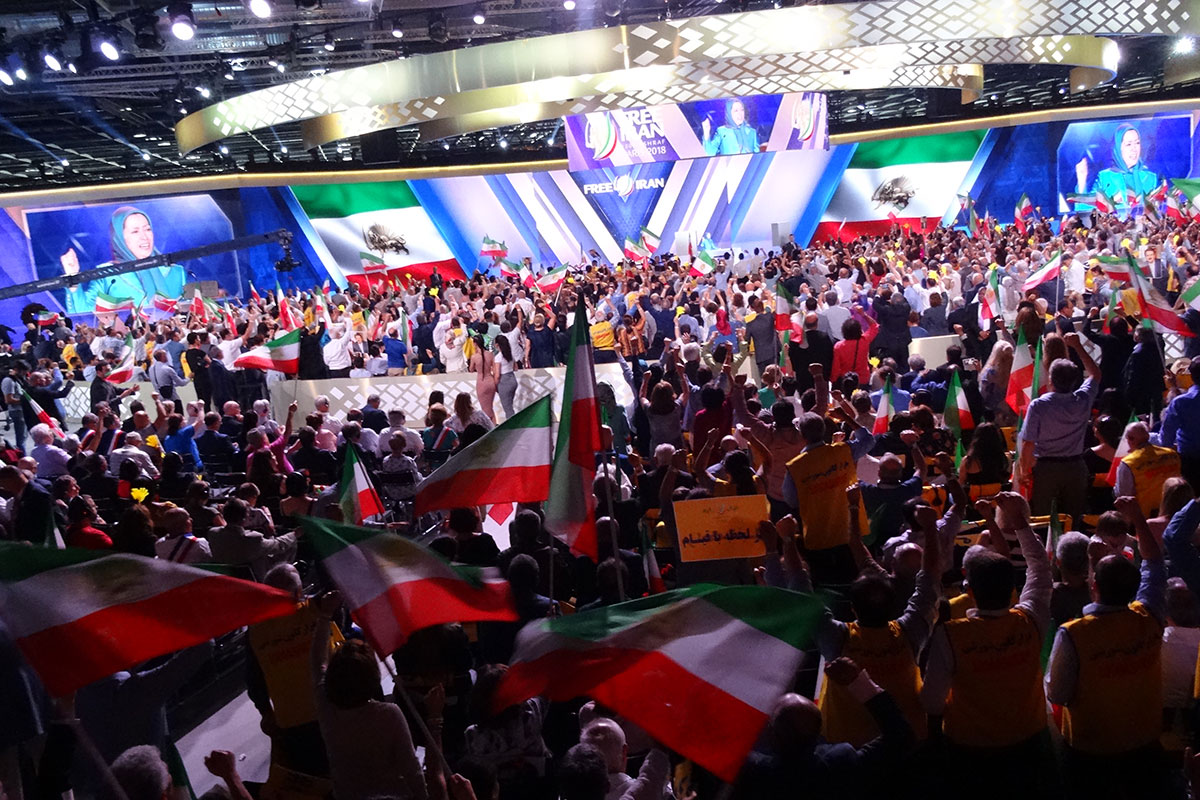
- https://www.maryam-rajavi.com/en/item/paris-gathering-shows-growing-clout-of-anti-iran-dissident-group
- https://www.maryam-rajavi.com/en/item/trump-allies-giuliani-gingrich-tell-paris-rally-end-near-for-iran-rulers
- https://www.maryam-rajavi.com/en/item/rajavi-regime-change-tehran-within-reach-now-more-than-ever
- https://www.maryam-rajavi.com/en/item/freedom-now-mass-rally-demands-regime-change-in-iran
- https://www.maryam-rajavi.com/en/item/fox-news-free-iran-rally-held-in-paris
- https://www.maryam-rajavi.com/en/item/the-iranian-resistance-grand-gathering-held-paris
- https://www.maryam-rajavi.com/en/item/free-iran-paris-conference-newt-gingrich-rudy-giuliani
- https://www.maryam-rajavi.com/en/item/maryam-rajavi-regime-overthrow-certain-iran-will-free
- https://www.maryam-rajavi.com/en/item/trump-ally-giuliani-says-end-is-near-for-iran-rulers
- https://www.maryam-rajavi.com/en/item/iran-the-alternative
- https://www.maryam-rajavi.com/en/item/paris-free-iran-with-hundreds-top-personalities-lawmakers-elected-representatives
- Tags: Iran, Iran protests, Middle East

